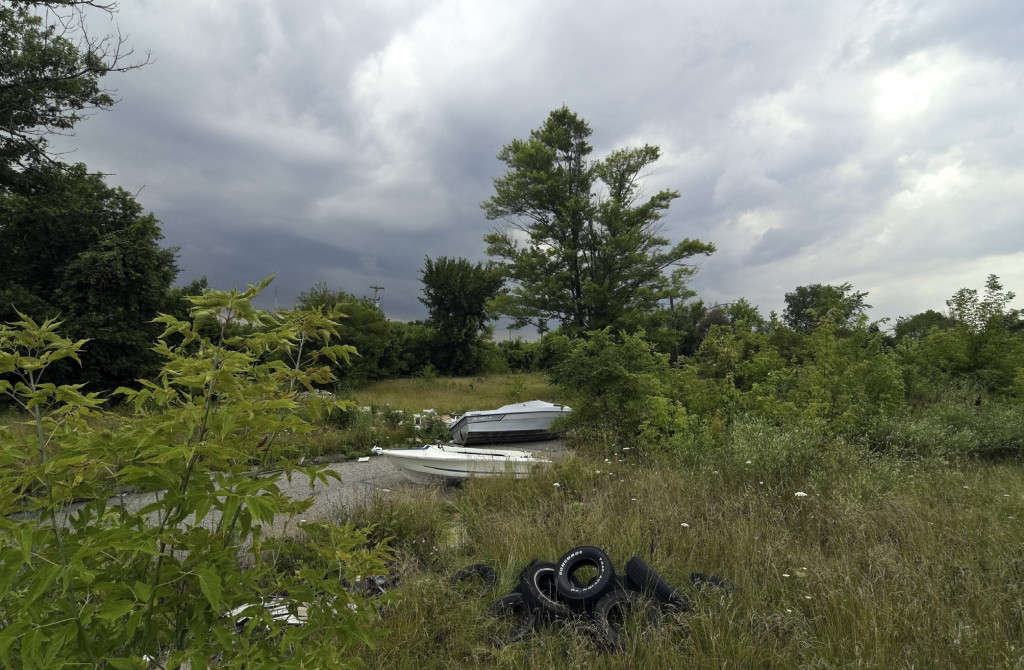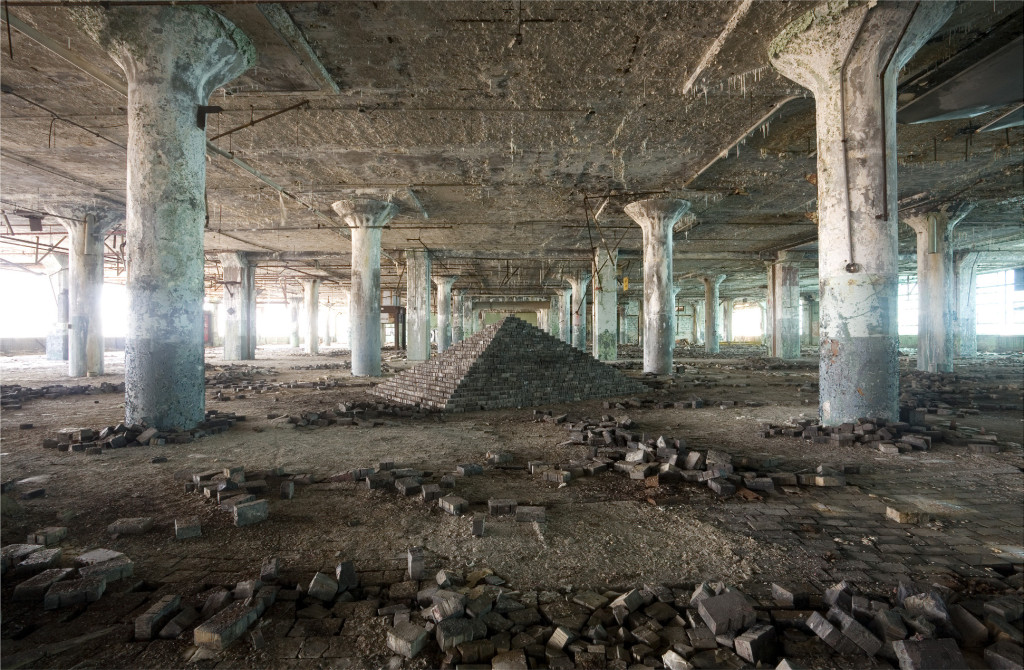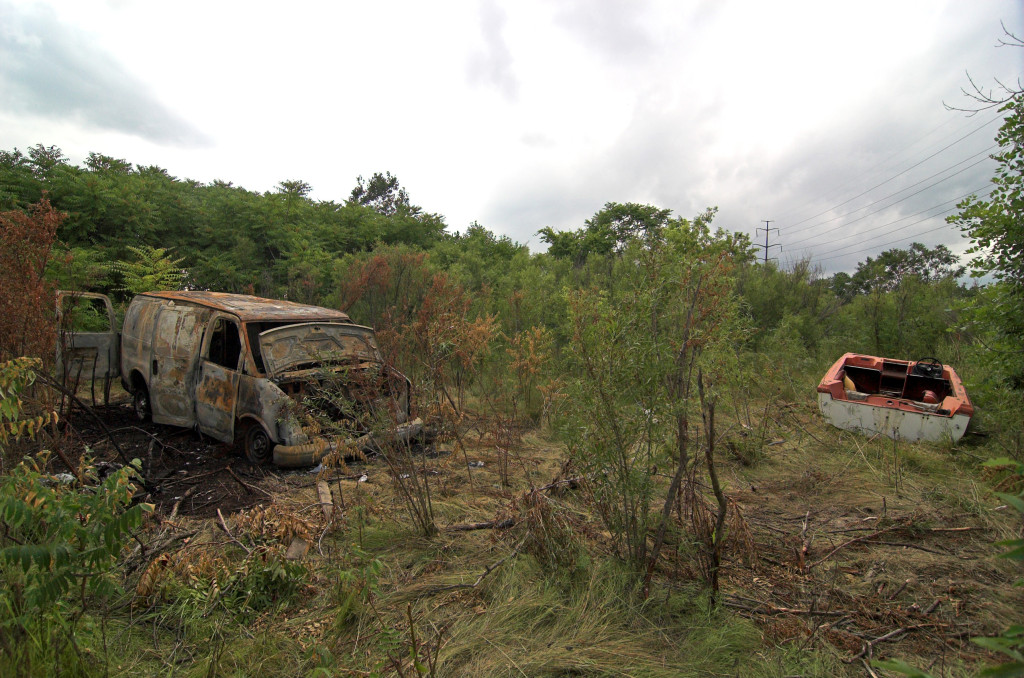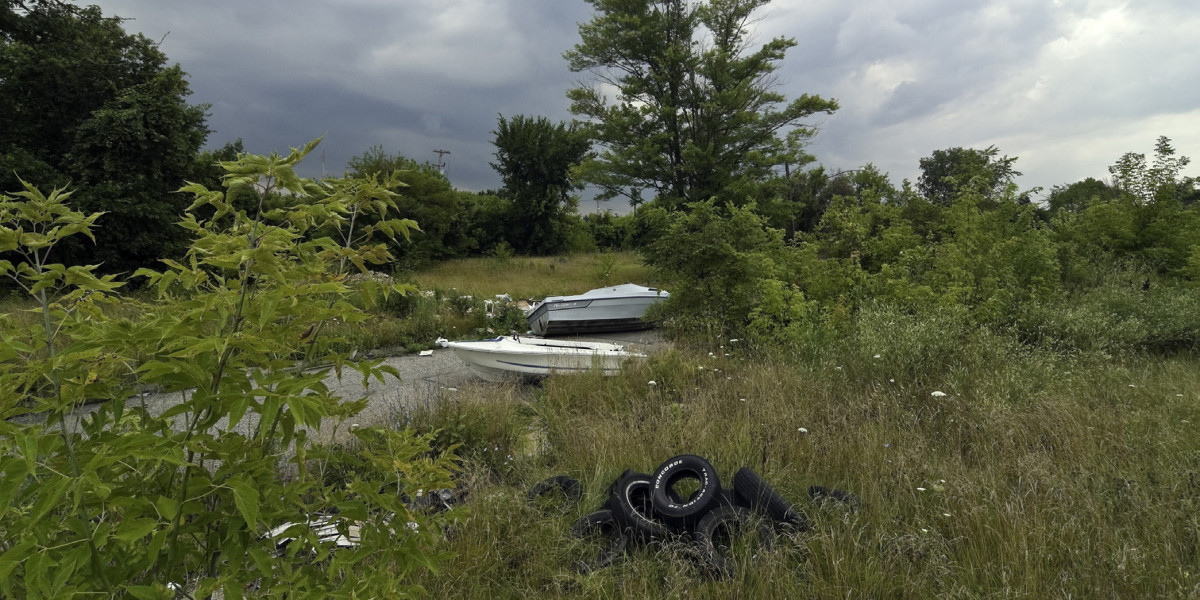A Nice Spot Along the Water
Scott Hocking

Fig. 1. Gilbo Boats, 2009, from the photography series Shipwrecks, 1999-2013
“Since the trade of the war is not that of a writer, I cannot without rashness draw the portrait of a country so worthy of a better pen than mine; but since you have ordered me to give you an account of it I will do so, telling you that Detroit is, probably, only a canal or a river of moderate breadth, and twenty-five leagues in length according to my reckoning lying north-north- east, and south-south-west about the 41st degree (of latitude), through which the sparkling and pellucid waters of Lakes Superior, Michigan and Huron (which are so many seas of sweet water) flow and glide away gently and with a moderate current into Lake Erie, into the Ontario or Frontenac, and go at last to mingle in the river St. Lawrence with those of the ocean. The banks are so many vast meadows where the freshness of these beautiful streams keeps the grass always green. These same meadows are fringed with long and broad avenues of fruit trees which have never felt the careful hand of the watchful gardener; and fruit trees, young and old, droop under the weight and multitude of their fruit, and bend their branches towards the fertile soil which has produced them. In this soil so fertile, the ambitious vine which has not yet wept under the knife of the industrious vine-dresser, forms a thick roof with its broad leaves and its heavy cluster over the head of whatever it twines round, which it often stifles by embracing it too closely. Under these vast avenues you may see assembling in hundreds the shy stag and the timid hind with the bounding roebuck, to pick up eagerly the apples and plums with which the ground is paved. It is there that the careful turkey hen calls back her numerous brood, and leads them to gather the grapes; it is there that their big cocks come to fill their broad and gluttonous crops. The golden pheasant, the quail, the partridge, the woodcock, the teeming turtle-dove, swarm in the woods and cover the open country intersected and broken by groves of full-grown forest trees which form a charming prospect which of itself might sweeten the melancholy tedium of solitude. There the hand of the pitiless mower has never shorn the juicy grass on which bison of enormous height and size fatten. The woods are of six kinds, -- walnut trees, white oaks, red, bastard ash, ivy, white wood trees and cottonwood trees. But these same trees are as straight as arrows, without knots, and almost without branches except near the top, and of enormous size and height. It is from thence that the fearless eagle looks steadily at the sun, seeing beneath him enough to glut his formidable claws. The fish there are fed and laved in sparkling and pellucid waters, and are none the less delicious for the bountiful supply (of them). There are such large numbers of swans that the rushes among which they are massed might be taken for lilies. The gabbling goose, the duck, the teal and the busted are so common there that, in order to satisfy you of it, I will only make use of the expression of one of the savages, of whom I asked before I got there whether there was much game there, “there is so much” he told me, “that it only moves aside (long enough) to allow the boat to pass.” Can it be thought that a land in which nature has distributed everything in so complete a manner could refuse to the hand of a careful husbandman who breaks into its fertile depths, the return which is expected of it? In a word, the climate is temperate, the air very pure; during the day there is a gentle wind, and at night the sky, which is always placid, diffuses sweet and cool influences which cause us to enjoy the benignity of tranquil sleep. If its position is pleasing, it is no less important, for it opens or closes the approach to the most distant tribes which surround these vast sweet water seas. It is only the opponents of the truth who are the enemies of this settlement, so essential to the increase of glory of the King, to the spread of religion, and to the destruction of the throne of Baal.”1Description of the Detroit River by M. de Lamothe (Cadillac), the Commandment there, October 8, 1701. The Windsor Border Region: Canada’s …

Fig. 2. Ziggurat, East, Summer II, 2008 – from the installation and photography project
Ziggurat and FB21, 2007-2009

Fig. 3. Shipwrecks, Carbon Works, 2007 – from the photography series Shipwrecks, 1999-
2013
Detroit has been many things. When Cadillac arrived just over 300 years ago, he found a narrow channel between two lakes, with Native camps on either side. It was a nice spot along the water. Soon, the marshlands, creeks, and forests became a rivertown. Land was divided into strip farms, each with a piece of shoreline. There were battles between the French, the British, and Natives of many kinds, and the Revolution came, and went. A great fire burned the town to the ground. Still, Detroit began anew. The location was ideal for trade, and from pelts to cigars to whiskey, the shipping industry grew into a boomtown. The War of 1812 and the Great Rebellion came, and went. With ore fl oated down from the north, Detroit became the stove builder, the carriage maker, and the automobile capital. It was coined the Paris of the West, the Arsenal of Democracy, and the enduring Motor City. It expanded away from the river, less dependent on the waterways as paved roads and superhighways were built. All the while things were changing, and as the industry moved, so did the people. In the last 50 years the population dropped nearly 50 percent, as residents and businesses left. Thousands of dwellings, factories, and neighborhoods were abandoned, demolished, decayed. Vacant lots turned to prairies, trees sprouted through cracked pavement and tar roofs, and the overgrown rubble of demolished homes became hills. Nature returned to reclaim, dismantle, and erode the unused spaces. And now, after 100 years of the Automobile Age, the future of Detroit City is unknown. But that’s just the last 300 years. People have been living along d’étroit for thousands of years. When Europeans first arrived, there were hundreds of ancient burial mounds, earthworks, and tumuli along the Detroit and Rouge rivers. They were so old; the Natives knew only legends of their mysterious builders. Long before the many Algonquin tribes, the Wyandot, the six Iroquois nations, and the Tuteloes set up camp along the strait, cultures known as the Mound Builders existed for centuries. It has been debated who these people were: the Hopewell, the Adena, the Mississippian societies, or even Phoenician copper-mining mariners. Cadillac himself theorized that perhaps these earthen monuments and reliquaries were remnants of the lost tribes of Israel. What is certain is that these sites were not unlike the pyramids, ziggurats, temples, and structural artifacts found worldwide: they were used for burial, and perhaps ceremonial and/ or military purposes. Yet, even the Mound Builders were not the first to inhabit the area. Humans of the early Woodland and Late Archaic periods were living along the shores of the Detroit and the Rouge rivers at the time of Christ. Ancient garden beds and bermed pathways lay fossilized under Michigan soil. And evidence of the Old Copper Complex shows that Natives were traveling great lengths to reap the glacially exposed copper of northern Michigan between 5,000 and 8,000 years ago. It’s clear that the “sparkling and pellucid” waters have attracted explorers and harbored travelers for thousands of years. So here is Detroit, at the threshold of another rebirth. The city of industry may be dying, but this is not the death of d’étroit. The last 300 years have seen many changes, but one thing has not changed much in the last 3,000 years. And maybe this course of events will lead to rediscovering the one unwavering reason that Detroit will continue on: The River. It turns out that this is still a pretty nice spot along the water.
Elliot M Abrams and Corinne Freter (editors), The Emergence of the Moundbuilders. Ohio University Press, Athens, 2005.
Vivian M. Baulch, Michigan’s Mysterious Indian Mounds, The Detroit News. June 6, 1997.
John T. Blois, Gazetteer of the State of Michigan, Antiquities through History, pages 161-196. Sydney L. Rood & Co., Detroit, 1839.
Silas Farmer, History of Detroit and Wayne County and Early Michigan. Silas Farmer and Co. 1890, Third Edition, Gale Research Company, Detroit, 1969.
Peter Gavrilovich and Bill McGraw (editors), The Detroit Almanac. The Detroit Free Press, Detroit, 2000.
Henry Gillman, The Mound Builders and Platycnemism in Michigan, Annual Report of the Smithsonian Institution for 1873, pages 364-390. Government Printing Offi ce, Washington, 1874.
W.B. Hinsdale, Primitive Man in Michigan. University of Michigan Press, Ann Arbor 1931.
Bela Hubbard, Memorials of a Half Century, pages 199-262. G. P. Putnam’s Sons, New York, 1887.
Thomas L. Jones, Up in Smoke: Cigar Making in Detroit, The Detroit News. February 18, 2000.
Dr. E.W. Johnson and David Johnson (editors), The Old Copper Complex, North America’s First Metal Miners and Artisans. http://copperculture.homestead.com/ 2009. William J. Kubiak, Great Lakes Indians. Baker Book House Company, Grand Rapids, 1970.
Henriette Mertz, The Mystic Symbol: Mark of the Michigan Mound Builders. Global Books, Gaithersburg, Maryland, 1986. 2nd Printing, Hayriver Press, Colfax, Wisconsin, 2004.
Arthur Pound, Detroit, Dynamic City. D. Appelton-Century Company Inc., New York, 1940.
George I. Quimby, Indian Life in the Upper Great Lakes. University of Chicago Press, Chicago, 1960.
Sister M. Rosalita, I.H.M.m Detroit: The Story of Some Street Names. Wayne University Press, Detroit, 1951.
Henry R. Schoolcraft, LL.D., History of the Indian Tribes of The United States. J. N. Lippincott & Co., Philadelphia, 1857.
Ephraim Squier and Edwin Davis, Ancient Monuments of the Mississippi Valley. Smithsonian Institute, Washington, 1848, Edited by David Meltzer, Smithsonian Classics of Anthropology, 1998.
References
